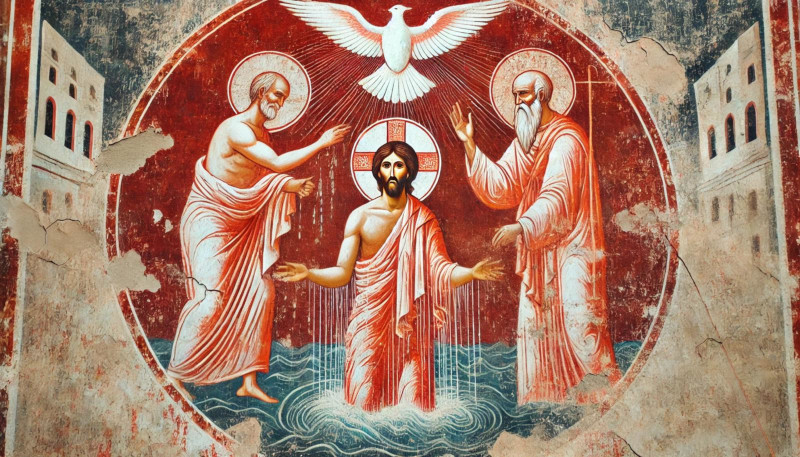
Parolin consecrates the Church of the Baptism of Jesus in Jordan
Church of the Baptism of Jesus in Jordan consecrated. To celebrate the rite, the pope sent Cardinal Parolin
“Let the hearts of the leaders of nations be persuaded to seek peace and coexistence among peoples. Let not violence determine our future,” Cardinal Secretary of State Pietro Parolin said Jan. 10, 2025, as he presided over the Mass for the consecration of the new Church of the Baptism of Jesus on the Jordan, at the site where John the Baptist baptized the Son of God.
Pope Francis had told the diplomatic corps accredited to the Holy See the day before Jan. 9, 2025, “World War III is a concrete threat,” it must be averted at all costs, “dialoguing even with those who are inconvenient.”
Strong is Parolin’s appeal for a “ceasefire,” the release of hostages and respect for humanitarian law while Latin Patriarch Cardinal Pierbattista Pizzaballa of Jerusalem calls for prayers “for those who suffer from the lack of peace.”
In his homily – read in Arabic by a reader – Cardinal Parolin stresses that his presence, sent by the Pope, represents “a tangible sign of the closeness of the whole Church to the Christian communities of the Middle East, a closeness expressed in many ways by the Pontiff in these months of war and pain.”
He refers to the letter Bergoglio sent to Catholics in the Middle East on Oct. 7, 2024, the first anniversary of the massacre carried out by Hamas on defenseless Israelis: “Christians,” wrote the Bishop of Rome, “are a seed of hope, a small seed surrounded by darkness but a seed that bears fruit.
Therefore,” Parolin added, ”do not let yourselves be overcome by grave difficulties, in the confidence that God governs human history, even if it bears the signs of violence, sin and death.
He reiterates the importance that “Christians can make their contribution to a just and peaceful society.” He looks across the Jordan River-i.e., to Israel and the Gaza Strip-and calls for “the silencing of weapons, the release of prisoners and hostages, the guarantee of humanitarian law, and the hearts of the leaders of nations to be persuaded to seek peace and coexistence among peoples.”
The site of the Baptism of Jesus represents “the lowest place on earth in which all the suffering of conflict, inhumanity and sin is felt,” but in this place, the papal legate recalls, “heaven has opened and we invoke the gift of true peace, which is born in hearts and spreads throughout the social fabric.”
He urges to “give thanks to God not only for the new church, but also for his having become man and having passed among us in this Holy Land.”
He thanked, also on behalf of Pope Bergoglio, the Royal House, King Abdullah II and the government of Jordan “for the care” they have had and have for this site and other places in the Hashemite Kingdom that bear witness to the presence of Christ and the early Church.
King Abdullah II is the only man of peace in a vast area of the Middle East dominated by dictatorial and warmongering regimes, regions that – the Pontiff recalls – “are marred by wars waged by the powerful.”
But this is “a moment of joy for the Church in Jordan and for the entire universal Church,” recalls the apostolic nuncio to Jordan, Msgr. Giovanni Pietro Dal Toso, while Patriarch Pizzaballa prays “for all those who suffer because of the lack of security, stability and peace, especially in Palestine, Lebanon and Syria, as in all regions of the world.”
The archaeological site was identified in the 1990s by Franciscan archaeologist Michele Piccirillo; on his trip to the Holy Land in 2009 Benedict XVI blessed the foundation stone of the “Church of Baptism” at the Jordan River.
The place is called “Al-Maghtas,” literally “the immersion,” where once stood the “Bethany beyond the Jordan” recorded in the Gospels and which archaeologists – of whom the best known is Michele Piccirillo – believe is most likely the place where Jesus was baptized by John the Baptist.
The identification is attested by the fact that as many as three churches were built in Byzantine times, as witnessed by early pilgrims. Marble steps described in the 6th century by Antoninus Martyr that descend to the river and where priests once administered baptisms have been discovered there.
The new Latin church was built with contributions from a number of benefactors, mainly Jordanians, on land entrusted by the royal family to the various local Christian communities. A land that until the mid-1990s was in a mined area, being adjacent to the Jordan River that marks the border between Jordan and Israel.
The consecration of the church coincides with the feast of Epiphany, understood as the manifestation of the Trinity during baptism, solemnly celebrated by Middle Eastern churches.
The church has been designated as a pilgrimage destination for the faithful to receive plenary indulgence during the Jubilee of Hope.
Source
- La Voce e il Tempo
